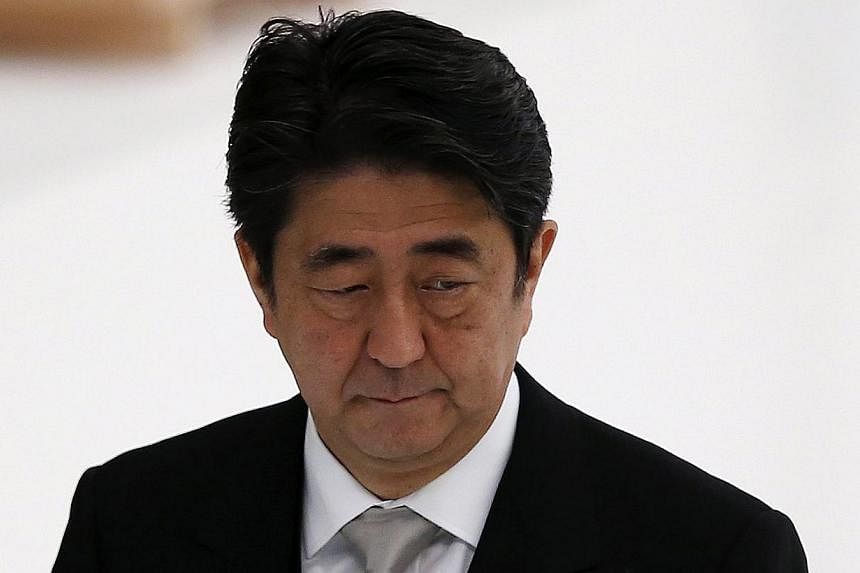TOKYO (REUTERS) - Prime Minister Shinzo Abe's plan for Japan's economy to generate self-sustained growth on the back of his three policy "arrows" of massive monetary easing, spending and reform appears to be faltering - but no magic solution is in sight.
Mr Abe's aides and advisers are promising to forge ahead with painful structural reforms, while spreading the benefits of "Abenomics" to regional areas and drafting a long-term vision for addressing Japan's shrinking population.
But gloomy economic data suggests the plan is not succeeding as hoped and the only short-term contingency plans appear to be further central bank stimulus or delaying a second rise in the sales tax set for October 2015.
"Abenomics is in trouble - because it's not happening fast enough," said Mr Robert Feldman, head of research at Morgan Stanley MUFG in Tokyo, who like many others says Mr Abe must move faster on steps such as labour market reform to boost productivity.
Failure could leave Japan's economy stuck in a low-growth mode or worse, unable to begin to curb public debt already more than twice the size of a US$5 trillion (S$6.25 trillion) economy, the biggest burden in the industrialised world.
Mr Abe's public support, now hovering around 50 per cent, depends heavily on the economy. Most voters favour delaying next year's sales tax rise to 10 per cent after an initial hike in April to 8 per cent from 5 per cent dented a fragile recovery.
"Will raising the sales tax a second time just when the economy is moving toward recovery really be a plus for the people's livelihoods?" Mr Koichi Hagiuda, an aide to Mr Abe in his Liberal Democratic Party (LDP), said in an interview. "But there is also a risk to postponing it. Might not Japan lose the confidence of international society?" Mr Hagiuda added.
The two-stage rise in the consumption tax is Japan's boldest move in nearly two decades to rein in government debt.
Mr Abe will formally launch stage two of his administration on Wednesday when he reshuffles his Cabinet, although key members are expected to stay on.
The new Cabinet will take over after a slew of troubling data including an annualised 6.8 per cent drop in GDP in the April-June quarter.
Potentially more worrisome, real wages have fallen for 13 straight months as wage growth lags price rises, data on Tuesday showed.
That drop is casting doubt on a central tenet of Abenomics - that stimulus and higher prices would lift company profits and lead to higher wages, spurring consumption and making growth self-sustaining. "In order for income effects to work, wages must increase," Mr Etsuro Honda, a key architect of Abe's reflationary policies, told Reuters.
Mr Honda said the sales tax rise should be delayed until 2017 and only imposed then if wage rises catch up with inflation and the BOJ's 2 per cent inflation target has been met.
Policymakers say that, unlike the initial round of Abenomics, when the Bank of Japan unleashed an intense burst of stimulus followed by public works and other government spending, the "third arrow" of deregulation and other structural reforms will take both time and political will. "The growth strategy is not a single arrow. There are many things that must be done that were put off during 20 years of deflation," said one private economist who advises Mr Abe's government on policies.
The premier's aides have made clear they want companies to play a bigger role in the revival, and not just rely on the benefits of a weak yen born of the Bank of Japan's easy money policy.
"In a sense, the first arrow of monetary policy easing was a way of buying time," Vice Economy Minister Yasutoshi Nishimura told Reuters. "I want companies themselves, led by shareholders, to exit unprofitable businesses and shift to new growth areas."
Private economists say for that to happen, the government must step up the pace of deregulation and other changes such as reform of labour laws.
For now, though, the political calendar looks likely to dictate a focus on persuading voters outside the capital they have not been left out of a programme that has so far benefited mostly big companies and Tokyo.
Mr Abe's LDP faces several elections for local governors in October and November as well as nationwide polls for local assemblies next April. A poor showing could affect his chances of winning a second three-year term in party leadership race a year from now.
That has some Abe advisers worried politicians may revert to old-style wooing of voters with spending, rather than reform. "I think they should opt for tough reforms, but politicians may not see it that way," Mr Heizo Takenaka, an economist and member of an advisory panel on regulatory reform, told Reuters.
Policymakers are also pledging to draft a vision of how to keep Japan's ageing population from shrinking into oblivion, holding the line at 100 million in 2060, a 20 per cent drop from now. While such long-term thinking would be welcome, economists said Mr Abe needs to speed up efforts to boost productivity.
"Abe must work harder to follow through his 'Third Arrow' by implementing labour market and other reforms that may prove painful near-term," said Mr Masamichi Adachi, senior economist at JPMorgan Securities Japan.

